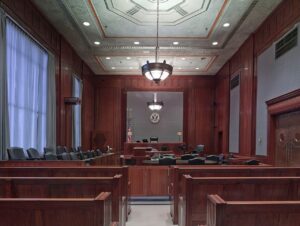Mae Zeitouni
The State of Florida v. Jamell Demons is an ongoing criminal case in Florida concerning popular rap artist Jamell Demons, more commonly known by his stage name YNW Melly.[1] Demons faces two first degree murder charges related to the 2018 deaths of Anthony Williams and Christopher Thomas.[2] This case has garnered a great deal of attention from the public, mainly in connection with Demons’ popular single “Murder on My Mind,” a rap single detailing homicidal ideations through a fictional story of Demons accidentally killing a friend.[3] After Demons’ first trial ended in a mistrial, the prosecution has sought to introduce the majority of Demons’ discography into evidence in his upcoming second trial. The prosecution hopes to cite the lyrics in Demon’s rap songs as proof of culpability, intent, and/or his real-life actions.[4] In a controversial decision, presiding Judge John Murphy has ruled that Demon’s lyrics are admissible evidence that the prosecution may use as part of their case.[5]
Demons is far from the first high-profile rapper to “face the music” in court, as the admissibility of artistic expression in criminal trials has been the subject of much discussion over the past few decades.[6] Over the past 30 years, rap lyrics have often been used as evidence in criminal trials—a strategy that has become increasingly popular with prosecutors over time.[7] For example, when hip-hop star Jeffery “Young Thug” Williams was charged with criminal racketeering under Georgia’s Racketeer Influenced and Corrupt Organizations Act (“RICO”) in 2023, a Fulton county judge ruled that Williams’ rap lyrics and music videos were “conditionally admissible” as long as the lyrics were relevant to proving either mens rea or actus reus.[8]
In essence, the lyrics must be “relevant” to be admissible. Under the Federal Rules of Evidence, relevance requires (1) that the evidence makes a fact more of less probable and (2) that the fact is a “fact of consequence.”[9] Rap lyrics cannot be used only to emphasize a defendant’s “bad character” or their general “propensity” to commit certain crimes.[10] Furthermore, under Federal Rule of Evidence 403, even if the evidence is considered to be relevant, courts ruling on the admissibility of evidence are required to weigh and balance the probative value of evidence against its potential to illicit unfair prejudice.[11] If the probative value of relevant evidence outweighs its prejudicial influence, the evidence may be admitted.[12] It is important to note courts often caution that unfair prejudice does not equate to evidence which will harm a party’s case, but rather to evidence which is likely to cause the case to be decided upon an improper basis.[13]
Even with the boundaries established by the Federal Rules, artistic expression and its relation to an alleged wrongdoing is largely uncontemplated by the law. Musicians often create fictional personas under which they produce their music. Consequently, it can be difficult to determine whether their artistic expression is based upon lived events or fabricated stories which fit with their fictitious character.[14] Thus, courts are faced with an additional responsibility in determining the admissibility of rap lyrics: whether the words/speech of the artist is based in reality or fiction.
There have been some efforts by legislators at both state and federal levels to resolve this issue, through either modification of jurisdictional evidentiary rules or sweeping legislation aiming to restrict the use of rap lyrics entirely; however, these efforts have not yet been widely successful.[15] While the problems surrounding the evidentiary admissibility of artistic expression, particularly rap lyrics, are not yet completely settled, inconsistent administration of such decisions could pose a problem.
[1] YNW Melly’s Double Murder Retrial On Pause As Prosecutor Appeal Judge Order Over Evidence, NBC6 (Jan. 26, 2024), https://www.nbcmiami.com/news/local/ynw-mellys-double-murder-retrial-on-pause-as-prosecutors-appeal-judge-order-over-evidence/3217421/.
[2] Mary Helen Moore, Grand Jury Indictment: YNW Melly Fired The Gun, Killing The Friends He Grew Up With, Treasure Coast Newspapers (Feb. 15, 2019), https://www.tcpalm.com/story/news/crime/2019/02/14/indictment-ynw-melly-shot-friends-staged-scene-look-like-drive-by/2868483002/.
[3] Kyle Eustice, YNW MELLY’S “MURDER ON MY MIND” NABS NO. 1 SPOT ON APPLE MUSIC AMID MURDER CHARGES, HipHopDX (Feb. 16, 2019), https://hiphopdx.com/news/id.50328/title.ynw-mellys-murder-on-my-mind-nabs-no-1-spot-on-apple-music-amid-murder-charges.
[4] Eddie Fu, YNW Melly’s Lawyer Thinks The Rappers Lyrics May Be Used As Evidence In Court, Genius (Apr. 9, 2019), https://genius.com/a/ynw-melly-s-lawyer-thinks-the-rapper-s-lyrics-may-be-used-as-evidence-in-court.
[5] Order Den. Def.’s Mot. to Suppress, State v. Demons, Dec. 18th, 2023, 19001872CF10A.
[6] See Cady Lang, What to Know About Young Thug’s Trial and the Controversial Use of Rap Lyrics in Criminal Cases, Time Magazine (Jun. 29, 2022), https://time.com/6192371/young-thug-rap-lyrics-evidence-court/; Jaeah Lee, This Rap Song Helped Sentence a 17-Year-Old to Prison for Life, N.Y. Times (Mar. 30, 2022), https://www.nytimes.com/2022/03/30/opinion/rap-music-criminal-trials.html.
[7] Emily Pecot, Using Rap Lyrics as Evidence In Court, New Jersey State Bar Assoc. (Feb. 15, 2023), https://njsbf.org/2023/02/15/using-rap-lyrics-as-evidence-in-court/.
[8] Bill Hochberg, Why Rap Lyrics Can Be Used In Young Thug’s Trial, But Not In Jam Master Jay’s Case, Forbes (Feb. 27, 2024), https://www.forbes.com/sites/williamhochberg/2024/02/27/why-jam-master-jay-and-young-thugs-trials-differ-on-rap-lyrics/?sh=236e933c2036. Mens rea refers to the state of mind which the defendant must be proved to have had at the time of the relevant conduct while actus reus refers to the outward conduct which must be proved against the defendant. Id.
[9] Fed. R. Evid. 401; Fed. R. Evid. 402.
[10] Fed. R. Evid. 404.
[11] Fed Rules Evid. R 403.
[12] Fed Rules Evid. R 403; see State v. Cheeseboro, 552 S.E.2d 300, 313 (2002) (“We find these references too vague in context to support the admission of this evidence. The minimal probative value of this document is far outweighed by its unfair prejudicial impact as evidence of appellant’s bad character i.e. his propensity for violence in general . . . these lyrics contain only general references glorifying violence. Accordingly, the Ruckus song should have been excluded.”)
[13] Kelly McGlynn, Lyrics in Limine: Rap Music and Criminal Prosecutions, ABA (Jan. 11, 2023), https://www.americanbar.org/groups/communications_law/publications/communications_lawyer/2023-winter/lyrics-limine-rap-music-and-criminal-prosecutions.
[14] Id.






